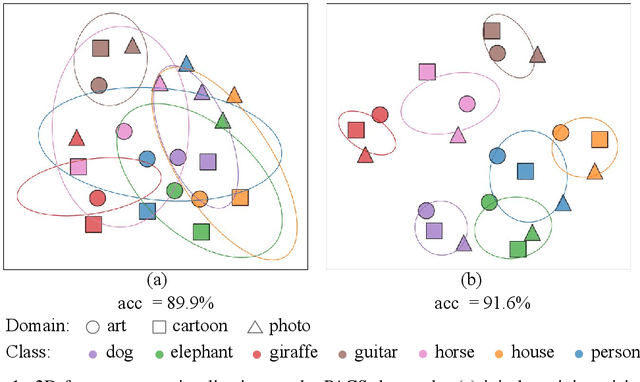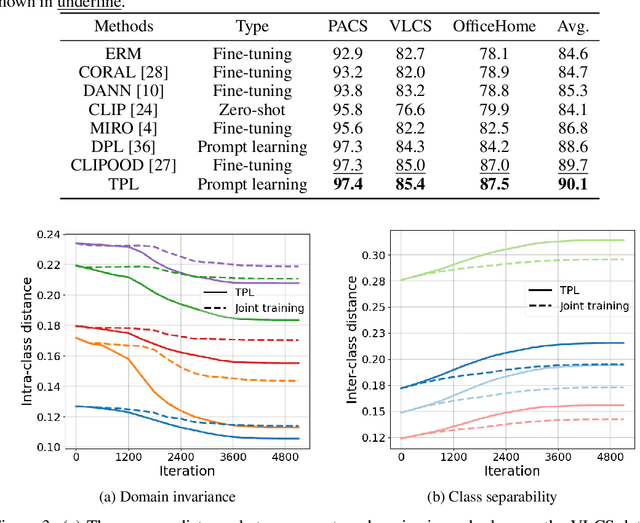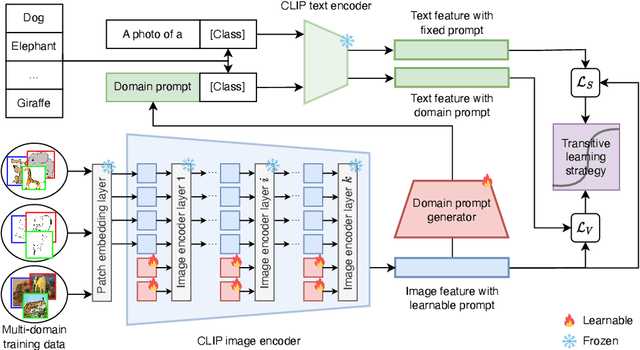Hanzi Wang
FATE: A Prompt-Tuning-Based Semi-Supervised Learning Framework for Extremely Limited Labeled Data
Apr 14, 2025Abstract:Semi-supervised learning (SSL) has achieved significant progress by leveraging both labeled data and unlabeled data. Existing SSL methods overlook a common real-world scenario when labeled data is extremely scarce, potentially as limited as a single labeled sample in the dataset. General SSL approaches struggle to train effectively from scratch under such constraints, while methods utilizing pre-trained models often fail to find an optimal balance between leveraging limited labeled data and abundant unlabeled data. To address this challenge, we propose Firstly Adapt, Then catEgorize (FATE), a novel SSL framework tailored for scenarios with extremely limited labeled data. At its core, the two-stage prompt tuning paradigm FATE exploits unlabeled data to compensate for scarce supervision signals, then transfers to downstream tasks. Concretely, FATE first adapts a pre-trained model to the feature distribution of downstream data using volumes of unlabeled samples in an unsupervised manner. It then applies an SSL method specifically designed for pre-trained models to complete the final classification task. FATE is designed to be compatible with both vision and vision-language pre-trained models. Extensive experiments demonstrate that FATE effectively mitigates challenges arising from the scarcity of labeled samples in SSL, achieving an average performance improvement of 33.74% across seven benchmarks compared to state-of-the-art SSL methods. Code is available at https://anonymous.4open.science/r/Semi-supervised-learning-BA72.
Mind the Gap: Confidence Discrepancy Can Guide Federated Semi-Supervised Learning Across Pseudo-Mismatch
Mar 17, 2025Abstract:Federated Semi-Supervised Learning (FSSL) aims to leverage unlabeled data across clients with limited labeled data to train a global model with strong generalization ability. Most FSSL methods rely on consistency regularization with pseudo-labels, converting predictions from local or global models into hard pseudo-labels as supervisory signals. However, we discover that the quality of pseudo-label is largely deteriorated by data heterogeneity, an intrinsic facet of federated learning. In this paper, we study the problem of FSSL in-depth and show that (1) heterogeneity exacerbates pseudo-label mismatches, further degrading model performance and convergence, and (2) local and global models' predictive tendencies diverge as heterogeneity increases. Motivated by these findings, we propose a simple and effective method called Semi-supervised Aggregation for Globally-Enhanced Ensemble (SAGE), that can flexibly correct pseudo-labels based on confidence discrepancies. This strategy effectively mitigates performance degradation caused by incorrect pseudo-labels and enhances consensus between local and global models. Experimental results demonstrate that SAGE outperforms existing FSSL methods in both performance and convergence. Our code is available at https://github.com/Jay-Codeman/SAGE
Classifying Long-tailed and Label-noise Data via Disentangling and Unlearning
Mar 14, 2025Abstract:In real-world datasets, the challenges of long-tailed distributions and noisy labels often coexist, posing obstacles to the model training and performance. Existing studies on long-tailed noisy label learning (LTNLL) typically assume that the generation of noisy labels is independent of the long-tailed distribution, which may not be true from a practical perspective. In real-world situaiton, we observe that the tail class samples are more likely to be mislabeled as head, exacerbating the original degree of imbalance. We call this phenomenon as ``tail-to-head (T2H)'' noise. T2H noise severely degrades model performance by polluting the head classes and forcing the model to learn the tail samples as head. To address this challenge, we investigate the dynamic misleading process of the nosiy labels and propose a novel method called Disentangling and Unlearning for Long-tailed and Label-noisy data (DULL). It first employs the Inner-Feature Disentangling (IFD) to disentangle feature internally. Based on this, the Inner-Feature Partial Unlearning (IFPU) is then applied to weaken and unlearn incorrect feature regions correlated to wrong classes. This method prevents the model from being misled by noisy labels, enhancing the model's robustness against noise. To provide a controlled experimental environment, we further propose a new noise addition algorithm to simulate T2H noise. Extensive experiments on both simulated and real-world datasets demonstrate the effectiveness of our proposed method.
You Are Your Own Best Teacher: Achieving Centralized-level Performance in Federated Learning under Heterogeneous and Long-tailed Data
Mar 10, 2025Abstract:Data heterogeneity, stemming from local non-IID data and global long-tailed distributions, is a major challenge in federated learning (FL), leading to significant performance gaps compared to centralized learning. Previous research found that poor representations and biased classifiers are the main problems and proposed neural-collapse-inspired synthetic simplex ETF to help representations be closer to neural collapse optima. However, we find that the neural-collapse-inspired methods are not strong enough to reach neural collapse and still have huge gaps to centralized training. In this paper, we rethink this issue from a self-bootstrap perspective and propose FedYoYo (You Are Your Own Best Teacher), introducing Augmented Self-bootstrap Distillation (ASD) to improve representation learning by distilling knowledge between weakly and strongly augmented local samples, without needing extra datasets or models. We further introduce Distribution-aware Logit Adjustment (DLA) to balance the self-bootstrap process and correct biased feature representations. FedYoYo nearly eliminates the performance gap, achieving centralized-level performance even under mixed heterogeneity. It enhances local representation learning, reducing model drift and improving convergence, with feature prototypes closer to neural collapse optimality. Extensive experiments show FedYoYo achieves state-of-the-art results, even surpassing centralized logit adjustment methods by 5.4\% under global long-tailed settings.
CAPT: Class-Aware Prompt Tuning for Federated Long-Tailed Learning with Vision-Language Model
Mar 10, 2025Abstract:Effectively handling the co-occurrence of non-IID data and long-tailed distributions remains a critical challenge in federated learning. While fine-tuning vision-language models (VLMs) like CLIP has shown to be promising in addressing non-IID data challenges, this approach leads to severe degradation of tail classes in federated long-tailed scenarios. Under the composite effects of strong non-IID data distribution and long-tailed class imbalances, VLM fine-tuning may even fail to yield any improvement. To address this issue, we propose Class-Aware Prompt Learning for Federated Long-tailed Learning (CAPT), a novel framework that leverages a pre-trained VLM to effectively handle both data heterogeneity and long-tailed distributions. CAPT introduces a dual-prompt mechanism that synergizes general and class-aware prompts, enabling the framework to capture global trends while preserving class-specific knowledge. To better aggregate and share knowledge across clients, we introduce a heterogeneity-aware client clustering strategy that groups clients based on their data distributions, enabling efficient collaboration and knowledge sharing. Extensive experiments on various long-tailed datasets with different levels of data heterogeneity demonstrate that CAPT significantly improves tail class performance without compromising overall accuracy, outperforming state-of-the-art methods in federated long-tailed learning scenarios.
Augmentation Matters: A Mix-Paste Method for X-Ray Prohibited Item Detection under Noisy Annotations
Jan 03, 2025



Abstract:Automatic X-ray prohibited item detection is vital for public safety. Existing deep learning-based methods all assume that the annotations of training X-ray images are correct. However, obtaining correct annotations is extremely hard if not impossible for large-scale X-ray images, where item overlapping is ubiquitous.As a result, X-ray images are easily contaminated with noisy annotations, leading to performance deterioration of existing methods.In this paper, we address the challenging problem of training a robust prohibited item detector under noisy annotations (including both category noise and bounding box noise) from a novel perspective of data augmentation, and propose an effective label-aware mixed patch paste augmentation method (Mix-Paste). Specifically, for each item patch, we mix several item patches with the same category label from different images and replace the original patch in the image with the mixed patch. In this way, the probability of containing the correct prohibited item within the generated image is increased. Meanwhile, the mixing process mimics item overlapping, enabling the model to learn the characteristics of X-ray images. Moreover, we design an item-based large-loss suppression (LLS) strategy to suppress the large losses corresponding to potentially positive predictions of additional items due to the mixing operation. We show the superiority of our method on X-ray datasets under noisy annotations. In addition, we evaluate our method on the noisy MS-COCO dataset to showcase its generalization ability. These results clearly indicate the great potential of data augmentation to handle noise annotations. The source code is released at https://github.com/wscds/Mix-Paste.
Uncertainty-Aware Label Refinement on Hypergraphs for Personalized Federated Facial Expression Recognition
Jan 03, 2025



Abstract:Most facial expression recognition (FER) models are trained on large-scale expression data with centralized learning. Unfortunately, collecting a large amount of centralized expression data is difficult in practice due to privacy concerns of facial images. In this paper, we investigate FER under the framework of personalized federated learning, which is a valuable and practical decentralized setting for real-world applications. To this end, we develop a novel uncertainty-Aware label refineMent on hYpergraphs (AMY) method. For local training, each local model consists of a backbone, an uncertainty estimation (UE) block, and an expression classification (EC) block. In the UE block, we leverage a hypergraph to model complex high-order relationships between expression samples and incorporate these relationships into uncertainty features. A personalized uncertainty estimator is then introduced to estimate reliable uncertainty weights of samples in the local client. In the EC block, we perform label propagation on the hypergraph, obtaining high-quality refined labels for retraining an expression classifier. Based on the above, we effectively alleviate heterogeneous sample uncertainty across clients and learn a robust personalized FER model in each client. Experimental results on two challenging real-world facial expression databases show that our proposed method consistently outperforms several state-of-the-art methods. This indicates the superiority of hypergraph modeling for uncertainty estimation and label refinement on the personalized federated FER task. The source code will be released at https://github.com/mobei1006/AMY.
Video-to-Task Learning via Motion-Guided Attention for Few-Shot Action Recognition
Nov 18, 2024



Abstract:In recent years, few-shot action recognition has achieved remarkable performance through spatio-temporal relation modeling. Although a wide range of spatial and temporal alignment modules have been proposed, they primarily address spatial or temporal misalignments at the video level, while the spatio-temporal relationships across different videos at the task level remain underexplored. Recent studies utilize class prototypes to learn task-specific features but overlook the spatio-temporal relationships across different videos at the task level, especially in the spatial dimension, where these relationships provide rich information. In this paper, we propose a novel Dual Motion-Guided Attention Learning method (called DMGAL) for few-shot action recognition, aiming to learn the spatio-temporal relationships from the video-specific to the task-specific level. To achieve this, we propose a carefully designed Motion-Guided Attention (MGA) method to identify and correlate motion-related region features from the video level to the task level. Specifically, the Self Motion-Guided Attention module (S-MGA) achieves spatio-temporal relation modeling at the video level by identifying and correlating motion-related region features between different frames within a video. The Cross Motion-Guided Attention module (C-MGA) identifies and correlates motion-related region features between frames of different videos within a specific task to achieve spatio-temporal relationships at the task level. This approach enables the model to construct class prototypes that fully incorporate spatio-temporal relationships from the video-specific level to the task-specific level. We validate the effectiveness of our DMGAL method by employing both fully fine-tuning and adapter-tuning paradigms. The models developed using these paradigms are termed DMGAL-FT and DMGAL-Adapter, respectively.
Transitive Vision-Language Prompt Learning for Domain Generalization
Apr 29, 2024



Abstract:The vision-language pre-training has enabled deep models to make a huge step forward in generalizing across unseen domains. The recent learning method based on the vision-language pre-training model is a great tool for domain generalization and can solve this problem to a large extent. However, there are still some issues that an advancement still suffers from trading-off between domain invariance and class separability, which are crucial in current DG problems. However, there are still some issues that an advancement still suffers from trading-off between domain invariance and class separability, which are crucial in current DG problems. In this paper, we introduce a novel prompt learning strategy that leverages deep vision prompts to address domain invariance while utilizing language prompts to ensure class separability, coupled with adaptive weighting mechanisms to balance domain invariance and class separability. Extensive experiments demonstrate that deep vision prompts effectively extract domain-invariant features, significantly improving the generalization ability of deep models and achieving state-of-the-art performance on three datasets.
Dynamically Anchored Prompting for Task-Imbalanced Continual Learning
Apr 23, 2024



Abstract:Existing continual learning literature relies heavily on a strong assumption that tasks arrive with a balanced data stream, which is often unrealistic in real-world applications. In this work, we explore task-imbalanced continual learning (TICL) scenarios where the distribution of task data is non-uniform across the whole learning process. We find that imbalanced tasks significantly challenge the capability of models to control the trade-off between stability and plasticity from the perspective of recent prompt-based continual learning methods. On top of the above finding, we propose Dynamically Anchored Prompting (DAP), a prompt-based method that only maintains a single general prompt to adapt to the shifts within a task stream dynamically. This general prompt is regularized in the prompt space with two specifically designed prompt anchors, called boosting anchor and stabilizing anchor, to balance stability and plasticity in TICL. Remarkably, DAP achieves this balance by only storing a prompt across the data stream, therefore offering a substantial advantage in rehearsal-free CL. Extensive experiments demonstrate that the proposed DAP results in 4.5% to 15% absolute improvements over state-of-the-art methods on benchmarks under task-imbalanced settings. Our code is available at https://github.com/chenxing6666/DAP
 Add to Chrome
Add to Chrome Add to Firefox
Add to Firefox Add to Edge
Add to Edge